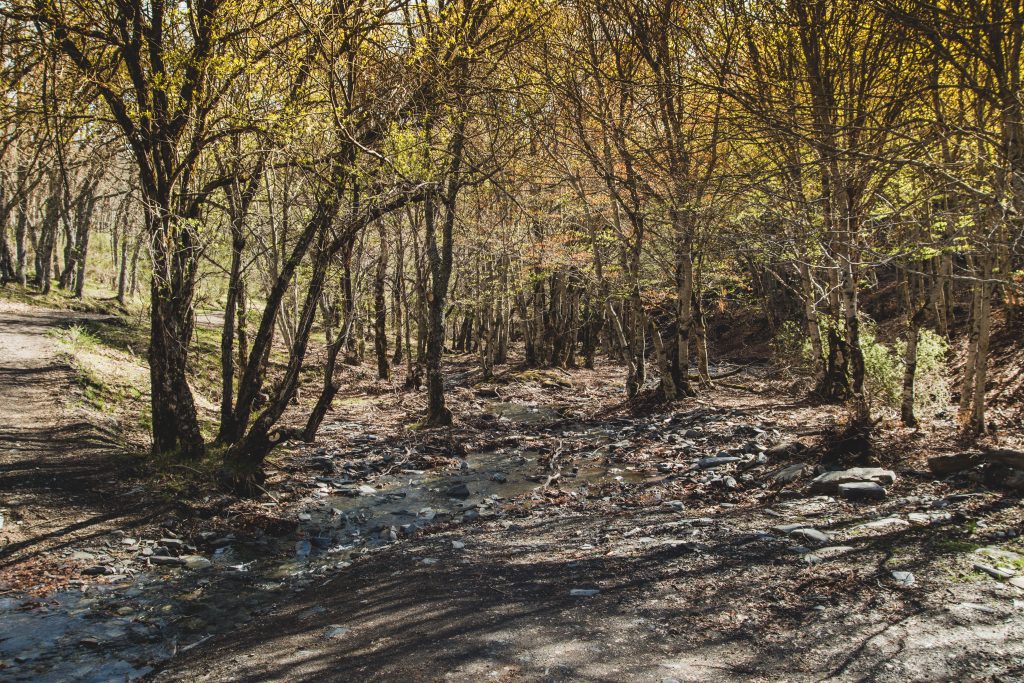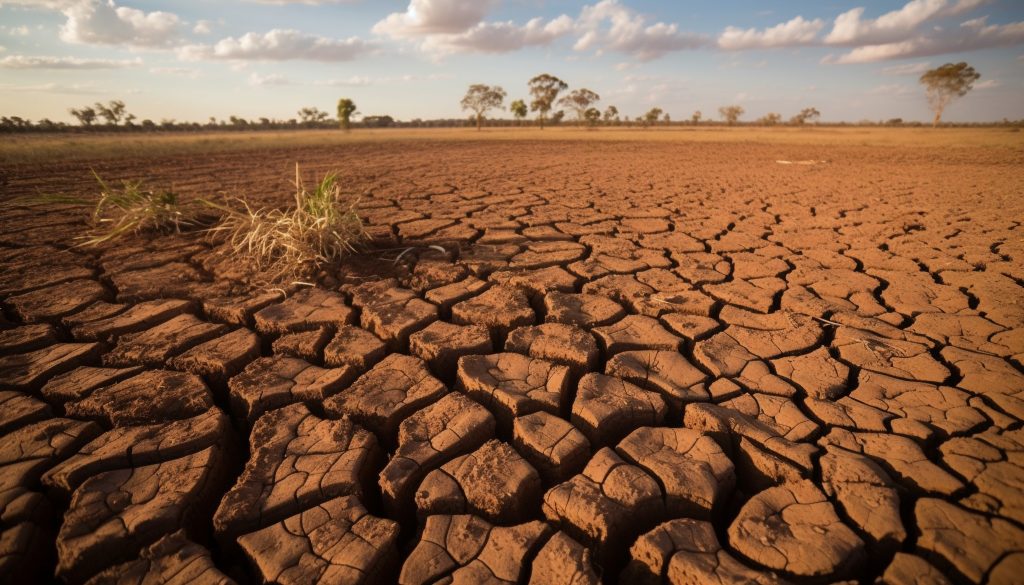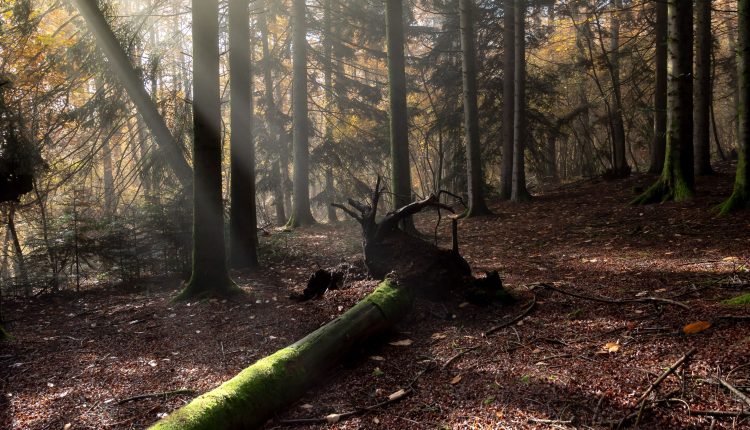THE ROLE OF TREES IN EROSION CONTROL
Erosion is a natural process by which the Earth’s surface is gradually worn away and reshaped by various natural forces, such as water, wind, ice, and gravity. It involves the movement of soil, rock particles, and other materials from one place to another, often leading to the gradual alteration of landscapes and the creation of distinctive landforms. Erosion can have both natural and human-induced causes, and its effects can range from subtle changes in the environment to significant geological transformations.

Mechanisms of Erosion:
- Water Erosion: Water erosion occurs when rainwater or flowing water dislodges and transports soil particles and sediments. Streams, rivers, rainfall, and even ocean waves can contribute to water erosion. It can create features such as river valleys, gullies, and canyons.
- Wind Erosion: Wind erosion happens when strong winds lift and transport loose particles of soil and sand. This is common in arid or desert regions where vegetation cover is sparse. Wind erosion can lead to the formation of sand dunes and the gradual reshaping of desert landscapes.
- Ice Erosion (Glacial Erosion): Glacial erosion is primarily caused by the movement of glaciers. As glaciers advance, they can scrape and pluck rock and sediment from the ground. The grinding action of rocks carried by glaciers creates distinct landforms such as cirques, valleys, and fjords.
- Gravity Erosion (Mass Movement): Gravity-induced erosion occurs when soil, rocks, and debris move downhill due to the force of gravity. This can lead to events like landslides, mudslides, and rockfalls.
Factors Influencing Erosion:
Several factors can influence the rate and severity of erosion:
- Rainfall Intensity: Heavier rainfall can cause more erosion by dislodging and carrying away soil particles.
- Slope and Gradient: Steeper slopes are more susceptible to erosion as gravity pulls materials downward more forcefully.
- Vegetation Cover: Vegetation, especially trees and plants with extensive root systems, helps stabilize soil and reduces erosion by holding soil particles in place.
- Soil Type and Structure: Different soil types have varying resistance to erosion. Well-structured soils with good aggregation are less prone to erosion.
- Human Activities: Activities such as deforestation, construction, mining, and improper agricultural practices can accelerate erosion by disturbing natural vegetation cover and altering the landscape.
- Climate: Different climates contribute to erosion in various ways. Arid regions with infrequent but heavy rainfall may experience intense water erosion during storms, while windy regions can face significant wind erosion.
Effects of Erosion:
- Loss of Topsoil: Erosion often removes the nutrient-rich top layer of soil, reducing soil fertility and hindering agricultural productivity.
- Landform Changes: Erosion can reshape landscapes by carving out valleys, cliffs, canyons, and other distinctive features.
- Sedimentation: Eroded soil and sediments can be transported to water bodies, leading to sedimentation, reduced water quality, and disrupted aquatic ecosystems.
- Habitat Destruction: Erosion can destroy habitats for plants and animals, leading to a loss of biodiversity.
- Floods and Landslides: Eroded materials can accumulate in waterways, increasing the risk of flooding, and destabilize slopes, leading to landslides.
- Coastal Erosion: Erosion along coastlines can result in the loss of valuable land and damage to infrastructure due to rising sea levels and wave action.
Efforts to control erosion include measures such as planting vegetation, constructing terraces, installing erosion control structures, and implementing proper land management practices. Sustainable land use and conservation efforts play a crucial role in mitigating erosion’s adverse impacts on the environment and society.
Importance of Erosion in Environmental Degradation
Erosion, while a natural process, can contribute to significant environmental degradation when it occurs at an accelerated rate or is exacerbated by human activities. The importance of erosion in environmental degradation lies in its potential to disrupt ecosystems, degrade soil quality, impact water bodies, and create various cascading effects that harm the environment. Here’s a closer look at the key reasons why erosion is a concern for environmental degradation:

- Soil Degradation: Erosion can strip away the fertile topsoil, which contains essential nutrients and organic matter necessary for plant growth. This loss of topsoil diminishes soil quality and agricultural productivity, leading to reduced crop yields and compromised food security.
- Loss of Biodiversity: Erosion can impact habitats, destroy vegetation, and displace organisms, resulting in a loss of biodiversity. Plant and animal species that depend on stable ecosystems can be threatened or driven to extinction due to the disruption caused by erosion.
- Water Quality Impairment: Eroded soil particles, along with any chemicals or pollutants they carry, can be transported to water bodies. This sedimentation and contamination can degrade water quality, harm aquatic life, and disrupt aquatic ecosystems.
- Stream and River Health: Increased sediment loads from erosion can lead to the siltation of rivers, streams, and waterways. This reduces water flow, alters sediment dynamics, and harms fish spawning grounds, leading to declines in fish populations.
- Coral Reef Degradation: Erosion and sediment runoff can negatively impact coral reefs by smothering corals and blocking sunlight. This contributes to coral bleaching and hinders reef growth, jeopardizing the health of these vital marine ecosystems.
- Climate Change Amplification: Eroded soil often contains organic carbon, which, when washed into water bodies, decomposes and releases greenhouse gases like carbon dioxide and methane. These gases contribute to climate change and further exacerbate environmental issues.
- Desertification: In arid and semi-arid regions, accelerated erosion can contribute to desertification – the process where fertile land becomes desert due to loss of vegetation and soil degradation. This results in the loss of land suitable for agriculture and settlement.
- Landslides and Infrastructure Damage: Erosion can destabilize slopes and hillsides, increasing the risk of landslides and rockfalls. These events can damage infrastructure, homes, and even cause loss of life.
- Economic Impact: The environmental degradation caused by erosion can have economic repercussions. Reduced agricultural productivity, increased treatment costs for contaminated water, and expenses related to rebuilding after landslides all impose financial burdens.
- Loss of Cultural and Historical Sites: Erosion can threaten cultural heritage sites, archaeological sites, and landscapes of historical significance, leading to the loss of cultural heritage.
- Sediment Export: Excessive erosion can lead to the export of large quantities of sediment downstream. This can alter riverbeds, impact water navigation, and lead to sediment accumulation in reservoirs, reducing their storage capacity.
Addressing erosion and mitigating its impacts requires sustainable land management practices, afforestation, reforestation, soil conservation techniques, and the adoption of erosion control measures. By recognizing the importance of erosion in environmental degradation, individuals, communities, and governments can work together to promote responsible land use and safeguard ecosystems for future generations.
Benefits of Trees in Erosion Control
Trees play a vital role in erosion control due to their intricate root systems, canopy coverage, and overall ecological impact. They contribute significantly to stabilizing soil, preventing erosion, and maintaining the health of ecosystems. Here’s an extensive explanation of the benefits of trees in erosion control:
- Root Systems and Soil Binding: Trees possess root systems that anchor the soil and prevent it from being easily washed away by water or blown away by wind. These roots create a network that holds soil particles together, increasing soil stability and cohesion. As the roots grow and spread, they effectively bind the soil and reduce its susceptibility to erosion.
- Canopy Coverage and Raindrop Impact: The canopy of trees intercepts rainfall, reducing the impact of raindrops hitting the soil surface directly. This is significant because raindrops can detach soil particles upon impact, leading to surface runoff and erosion. By providing a physical barrier, tree canopies shield the soil from the erosive force of raindrops, allowing water to infiltrate more gradually.
- Windbreaks and Wind Erosion Prevention: Trees planted in rows or clusters act as natural windbreaks, reducing wind speed and preventing the movement of soil particles. In areas prone to wind erosion, such as arid regions, trees serve as a barrier that shields the soil from being picked up and carried away by the wind. This function is particularly important in maintaining soil fertility and preventing desertification.
- Organic Matter Contribution: Fallen leaves, branches, and other plant debris create a protective layer on the soil surface. This layer, known as organic mulch, serves as a shield against the impact of raindrops and reduces the velocity of surface runoff. Organic matter also enhances soil structure, improving water-holding capacity and reducing soil compaction, both of which aid in erosion prevention.
- Promotion of Biodiversity: Trees contribute to the overall health of ecosystems by fostering biodiversity. A diverse array of plants, including trees, enhances soil structure, creating an intricate network of root systems that collectively stabilize the soil. These roots bind soil particles, reducing the risk of detachment and erosion. Moreover, a diverse ecosystem is more resilient to disturbances, including erosion events.
- Riparian Buffer Zones: Trees planted along riverbanks and streams create riparian buffer zones. These zones help stabilize the banks, preventing erosion due to flowing water. Additionally, the roots of riparian trees filter sediment and pollutants from runoff before they enter the water, leading to improved water quality downstream.
- Erosion Prevention Through Agroforestry: Integrating trees into agricultural practices, known as agroforestry, can significantly contribute to erosion control. By planting trees along contours or on slopes, farmers can create terraces that reduce surface runoff and erosion. Furthermore, agroforestry systems enhance soil fertility through leaf litter and nutrient cycling.
- Carbon Sequestration and Climate Regulation: Trees absorb carbon dioxide from the atmosphere, contributing to carbon sequestration. As they grow, they store carbon in their biomass and in the soil, playing a role in climate regulation. Healthy trees and forests help maintain stable climatic conditions, indirectly influencing erosion patterns.
In summary, trees provide a multifaceted and powerful set of tools for erosion control. Their root systems stabilize soil, their canopies shield against raindrop impact, and their presence enhances ecosystem health. Utilizing trees strategically in erosion-prone areas can effectively mitigate soil loss, protect water bodies, and foster sustainable land use practices. Whether as windbreaks, riparian buffers, or components of agroforestry systems, trees contribute significantly to maintaining a balanced and resilient environment.


Comments are closed.